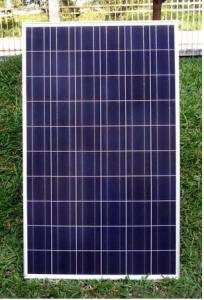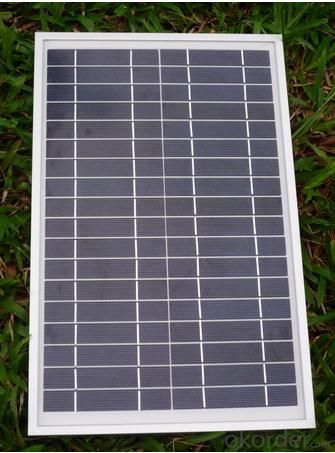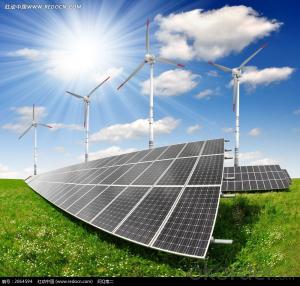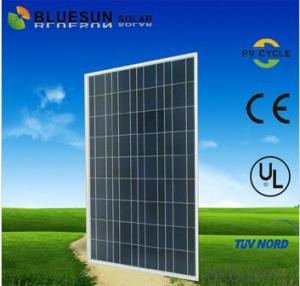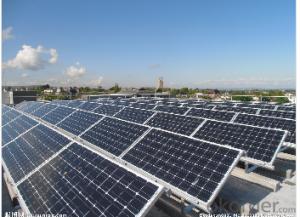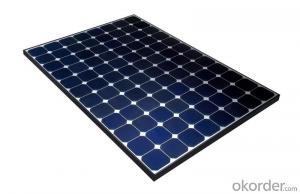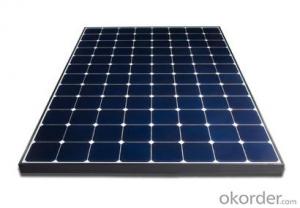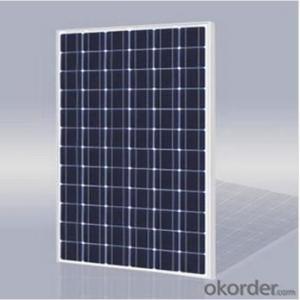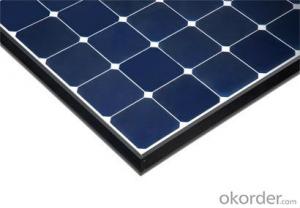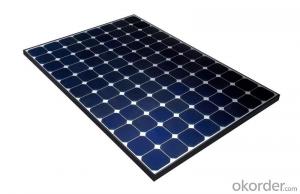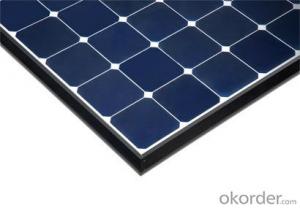Prius Solar Panels - Multicrystalline Solar Panel 165W A Grade for Commercial
- Loading Port:
- China main port
- Payment Terms:
- TT OR LC
- Min Order Qty:
- 1000 watt
- Supply Capability:
- 20000 watt/month
OKorder Service Pledge
OKorder Financial Service
You Might Also Like
Specification
Muticrystalline Solar Panel 155W A Grade For Commercial
Introduction
It is a form of photoelectric cell, defined as a device whose electrical characteristics, such as current, voltage, or resistance, vary when exposed to light. Solar cells are the building blocks of photovoltaic modules, otherwise known as solar panels.
Solar cells are described as being photovoltaic irrespective of whether the source is sunlight or an artificial light. They are used as a photodetector (for example infrared detectors), detecting light or other electromagnetic radiation near the visible range, or measuring light intensity.
In contrast, a solar thermal collector supplies heat by absorbing sunlight, for the purpose of either direct heating or indirect electrical power generation from heat. A "photoelectrolytic cell" (photoelectrochemical cell), on the other hand, refers either to a type of photovoltaic cell (like that developed by Edmond Becquerel and modern dye-sensitized solar cells), or to a device that splits water directly into hydrogen and oxygen using only solar illumination.
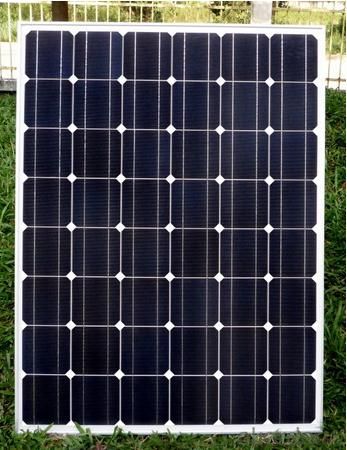
Suggested application
Home lighting business lighting,
Garden lighting, pavement lighting
Farmer household lighting
Product feature
modules are made of Monocrystalline or Polycrystalline Silicon cell.
Materials and color of the solar panel frame: Clear anodized aluminum alloy type 6063T5 Universal frame; Silver-white color;
The output connection gathers the coupling: Selects conforms to the IEC-612615; 2005, class II, IEC61730 international standard; Airtight waterproofing binding clamp;
Module seal structure: The surface is thick, the high diaphanous rate armored glass with solar cell board special-purpose 3.2mm becomes after the high temperature lamination craft. The back selects has waterproof and anti- aged performance fine TPT materials. The entire block battery board has, the waterproofing, the anti- aging airtight and so on the fine performance;
Power tolerance: +/-3%
Packaging
International standard cartons(according to the requirements of customers )
- Q: Can solar panels be installed on an RV or camper?
- Yes, solar panels can be installed on an RV or camper. This allows you to harness the power of the sun to generate electricity and charge your batteries, making your RV or camper more self-sufficient and reducing reliance on traditional power sources.
- Q: Can solar panels be installed on schools or universities?
- Yes, solar panels can definitely be installed on schools or universities. In fact, many educational institutions are taking advantage of solar energy to reduce their carbon footprint and save on energy costs. Solar panels can be easily installed on rooftops or open spaces within the campus, providing clean and renewable energy for various electrical needs of the school or university.
- Q: I don't have a regulator connected as they are a little expensive for a pensioner, If I join the panels into line to the battery bank from the roof should that be OK.?
- You can do this, but it isn't the best way to go. There is no problem with joining the solar panels. There are two ways to do this, in series and in parallel. A series combination will add the voltages that each panel is producing together, but not the amperages. For example, if five panels are producing 6V at 300mA each, the end result will be 30V at 300mA for a series array. A parallel combination combines the amperages of all the panels, but not the voltages. So, in our earlier example, five panels at 6V and 300mA would provide 6V and 500mA (.5A) if wired in parallel. Series-parallel combinations are also possible, giving some of the benefits of each method. This would probably better understood by doing a quick search on Google Images for series, parallel, and series-parallel. You CAN connect the solar panels directly to your battery bank with no regulator. Unfortunately, without a regulator, the connection is two-way. When the sun is out and the solar panels are producing more voltage than the batteries, the batteries will charge. However, when the panels are producing less voltage than the batteries, the batteries will instead send power into the solar panels, which will be dissipated and wasted. The panels may charge your batteries during the day, but they will discharge them at night.
- Q: I just moved into somewhere with solar panels but don't really understand them...all I know is that they heat the water.Do I still have to turn the hot water on with the solar panels or do they heat it automatically or do they store the energy until I turn on the hot water?!
- Custom solar-heating systems are unique. Does yours have a circulating pump? Does it have a storage tank? Is the fluid that goes to the panels separated from the household water and transfers heat through a heat-exchanger radiator, and the fluid has antifreeze in it? If it does, is the antifreeze of the variety that won't poison your family if there is a leak? Does your system have a thermostat-controlled pump that turns on when the water in the panels are hot? Does it have a limit-thermostat to turn off the pump when water in the storage tank is hot? There are many more variations to operation of solar-heating panels. Find out who designed it or who knows how to operate it and ask them.
- Q: How long does it take to recoup the cost of solar panels through energy savings?
- The time it takes to recoup the cost of solar panels through energy savings varies depending on various factors such as the cost of installation, the amount of sunlight received, the energy consumption of the household, and any applicable rebates or incentives. On average, it can take anywhere from 5 to 20 years to recoup the initial investment. However, with the decreasing costs of solar panels and the rising energy prices, the payback period is becoming shorter, making solar panels a more financially viable option for many homeowners.
- Q: Can it be used on a cellphone so u never have to worry about low battery?
- A solar panel (photovoltaic module or photovoltaic panel) is a packaged interconnected assembly of solar cells, also known as photovoltaic cells. The solar panel can be used as a component of a larger photovoltaic system to generate and supply electricity in commercial and residential applications.
- Q: I need to prepare solar panels for using in home needs electricity purpose. Can anyone could help me to know much more about it.
- It's possible to make a DIY homemade solar or wind power turbine to power your home, house, water pump, irrigation system and much more. You don't need to buy expensive wind turbine generator equipment. Trust me these wind power generator equipment cost so much that you could spend years saving to buy a very small unit. I live in a very windy and remote area in Kenya; Africa where it might be another 3 decades before the national power grid finally gets to our horizon. I was about to buy such equipment when I stumbled on a do it yourself manual online that had colorful illustrations of how to make a homemade wind turbine for as low as $200. Compare this to a small turbine unit that goes for no less than $ 3000 and you see what I mean when I say you are better off making one at home.
- Q: How do solar panels affect the property's branding and marketing?
- Solar panels can positively impact a property's branding and marketing by showcasing its commitment to sustainability and environmental responsibility. It can position the property as a forward-thinking and eco-friendly option, appealing to environmentally conscious consumers and potentially attracting a larger customer base. Additionally, solar panels can contribute to cost savings and energy efficiency, which can be highlighted as unique selling points, enhancing the property's marketability and competitiveness.
- Q: The colder a solar panel gets the more efficient it seems to be. As the panel warms, it loses some efficiency. Why is this so? Please explain in a way you would expect a high school kid to understand it, as I am a high-schooler and i have to explain this to other high-schoolers.
- All PV Solar Panels are affected by heat. The hotter the solar panel, the lower the power output - but how significant is the effect. I decided to test one of our small 6V 250mA Solar Panels to find out. Solar Panel next to halogen lamp with temperature probe. Reproducing the kind of temperatures solar panels experience in hot climates is not easy on a cloudy May day in the UK, so a 50 Watt halogen office lamp was used at a distance of 55mm from the solar panel as a sun substitute. This guaranteed a constant level of light would be incident upon the solar panel ensuring the quality of the results collected.
- Q: i wanted to buy solar panels but this guy told me one will just power one light bulb what i want to know is how much thay cost and is it true tat if more power leaves your house than goes in the power company has to send u a cheek
- If you are looking into a credit or buy back of hydro, you should be inquiring about windpower not solar...you will have better luck creating more with that than panels. It is not so much the cost of the panels that is a lot, it is the cost of everything else you will need to use/store the power....inverter, batteries...etc
Send your message to us
Prius Solar Panels - Multicrystalline Solar Panel 165W A Grade for Commercial
- Loading Port:
- China main port
- Payment Terms:
- TT OR LC
- Min Order Qty:
- 1000 watt
- Supply Capability:
- 20000 watt/month
OKorder Service Pledge
OKorder Financial Service
Similar products
Hot products
Hot Searches
